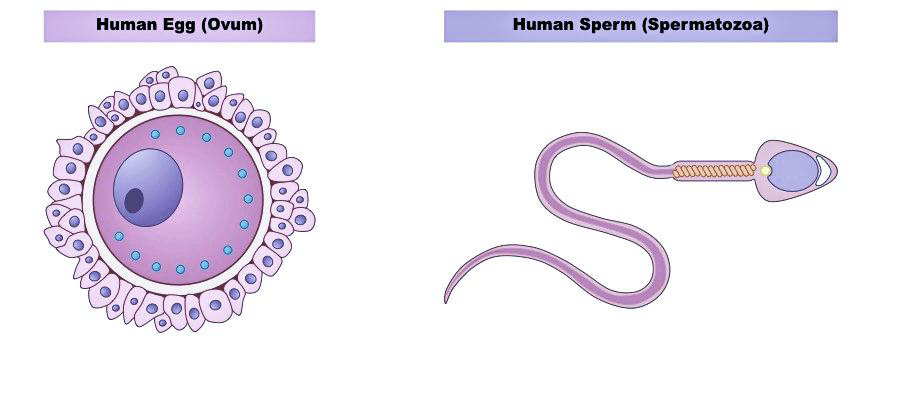
Compare the egg and the sperm in the human reproductive system. Which of the following are true?
Egg (Ovum) Sperm 1 It is the smallest cell in the human body. It is the biggest cell in the human body. 2 It does not move much. It moves actively. 3 It is a female reproductive cell. It is a male reproductive cell.
a. 1 and 2 only
b. 1 and 3 only
c. 2 and 3 only
d. 1, 2, and 3
| Egg (Ovum) | Sperm | |
| 1 | It is the smallest cell in the human body. | It is the biggest cell in the human body. |
| 2 | It does not move much. | It moves actively. |
| 3 | It is a female reproductive cell. | It is a male reproductive cell. |
Answer
481.2k+ views
Hint: The female reproductive cells remain inside the uterus while the male reproductive cells come across them to fuse.
Complete answer:
Female reproductive organs produce female reproductive cells called ovum or egg cells that are large and non-motile while male reproductive cells produce male reproductive cells called sperm that are small and motile.
Additional information:
-The egg cells are the female gamete while sperm is male gamete which is used in sexual reproduction.
-The fusion of sperm and egg will result in fertilization leading to the formation of zygote.
-The zygote will further undergo divisions to form a new complete organism.
-The process of formation of sperm cells is known as spermatogenesis.
-Oogenesis is termed for the process of formation of an egg cell.
-Sperm is the smallest cell of the human body while in a contrast egg cell is the largest cell of the human body.
The sperm consists of a tail-like structure that helps in the movement while an egg cell is embedded in the uterus and does not move.
-The egg cell is produced from the female gonads called ovaries while the sperm cell is produced from the male gonads called testicles.
So, the correct answer is ‘2 and 3 only'.

Note: The term sperm is derived from the Greek word Sperma meaning ‘seed’. The ovum was discovered in mammals in 1827 by Karl Ernst von Baer. It was proposed in 1578-1657, that every living cell comes from an egg cell by William Harvey. In starfish, the fusion of make and female gametes was first observed in 1876 by Oskar Hertwig.
Complete answer:
Female reproductive organs produce female reproductive cells called ovum or egg cells that are large and non-motile while male reproductive cells produce male reproductive cells called sperm that are small and motile.
Additional information:
-The egg cells are the female gamete while sperm is male gamete which is used in sexual reproduction.
-The fusion of sperm and egg will result in fertilization leading to the formation of zygote.
-The zygote will further undergo divisions to form a new complete organism.
-The process of formation of sperm cells is known as spermatogenesis.
-Oogenesis is termed for the process of formation of an egg cell.
-Sperm is the smallest cell of the human body while in a contrast egg cell is the largest cell of the human body.
The sperm consists of a tail-like structure that helps in the movement while an egg cell is embedded in the uterus and does not move.
-The egg cell is produced from the female gonads called ovaries while the sperm cell is produced from the male gonads called testicles.
So, the correct answer is ‘2 and 3 only'.

Note: The term sperm is derived from the Greek word Sperma meaning ‘seed’. The ovum was discovered in mammals in 1827 by Karl Ernst von Baer. It was proposed in 1578-1657, that every living cell comes from an egg cell by William Harvey. In starfish, the fusion of make and female gametes was first observed in 1876 by Oskar Hertwig.
Recently Updated Pages
Using the following information to help you answer class 12 chemistry CBSE

Basicity of sulphurous acid and sulphuric acid are

Master Class 12 Economics: Engaging Questions & Answers for Success

Master Class 12 Maths: Engaging Questions & Answers for Success

Master Class 12 Biology: Engaging Questions & Answers for Success

Master Class 12 Physics: Engaging Questions & Answers for Success

Trending doubts
Draw a labelled sketch of the human eye class 12 physics CBSE

What is the Full Form of PVC, PET, HDPE, LDPE, PP and PS ?

What are the major means of transport Explain each class 12 social science CBSE

Show variation of resistivity of copper as a function class 12 physics CBSE

Draw a neat and well labeled diagram of TS of ovary class 12 biology CBSE

Electrolysis of dilute H2SO4 generates H2S2O8 What class 12 chemistry CBSE




